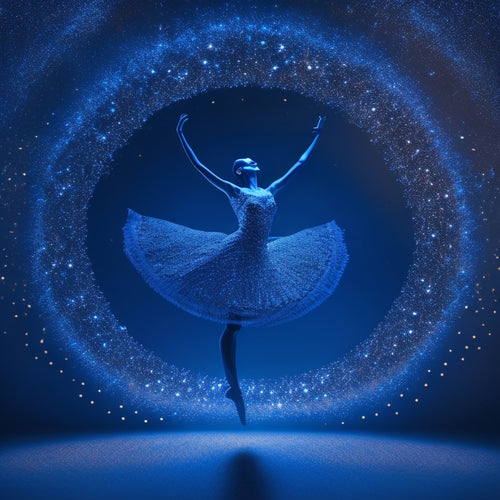
Unveiling the Artistry: Mastering Dance Professionally
Share
Mastering dance professionally demands a holistic approach. It begins with embracing a dance lifestyle, prioritizing self-care, nutrition, and mental well-being to maintain physical and mental health. Refined technique is built through precision training, focusing on alignment, movement pathways, and deliberate muscle engagement. Understanding the dance industry is also vital, requiring navigation of relationships, opportunities, and challenges, as well as networking and exposure through workshops and performances. As you explore the nuances of professional dance, you'll uncover the intricate balance of artistry, technique, and industry savvy required to thrive in this field, and discover the keys to accessing your full artistic potential.
Key Takeaways
• A deep commitment to the dance lifestyle is essential for a professional career, requiring immersion in the dance community and prioritizing self-care.
• Mastering dance technique requires precision training, focusing on alignment, efficient movement pathways, and deliberate muscle engagement to refine expression.
• Navigating the dance industry demands a deep understanding of relationships, opportunities, and challenges, including competition, physical demands, and uncertainty.
• Networking opportunities, such as attending workshops, festivals, and performances, are crucial for connecting with professionals and gaining exposure.
• A well-rounded dance lifestyle that balances physical and mental health enhances creativity, artistic growth, and overall career longevity.
Embracing the Dance Lifestyle
Starting a professional dance career requires a deep commitment to embracing the dance lifestyle, which involves a profound understanding of the art form and a willingness to dedicate oneself to an all-encompassing pursuit of excellence.
This means immersing oneself in the dance community, where like-minded individuals share a passion for the art form.
To achieve a harmonious lifestyle balance, dancers must prioritize self-care, nutrition, and mental well-being alongside their rigorous training schedules. By doing so, they can maintain their physical and mental health, ensuring a long and successful career.
A well-rounded dance lifestyle fosters creativity, innovation, and artistic growth, allowing dancers to thrive in their profession and make meaningful contributions to the dance community.
Refining Your Dance Technique
Three foundational elements - proper alignment, efficient movement pathways, and deliberate muscle engagement - form the cornerstone of a refined dance technique, allowing dancers to execute complex movements with precision, control, and expressiveness.
Perfecting movements through precision training is essential to mastering dance professionally. By focusing on precise alignment and efficient movement pathways, dancers can enhance their expression and create a deeper emotional connection with their audience.
Deliberate muscle engagement enables dancers to execute complex movements with control and precision, resulting in a more refined technique. Through dedicated practice and attention to detail, dancers can refine their technique, elevating their performance and captivating their audience.
Navigating the Dance Industry
As dancers progress from refining their technique to pursuing a professional career, maneuvering through the intricate landscape of the dance industry becomes an essential aspect of achieving success. Sailing through the dance industry requires a deep understanding of the complex web of relationships, opportunities, and challenges that define this competitive field.
Dancers must capitalize on networking opportunities, attending workshops, festivals, and performances to connect with industry professionals, gain exposure, and stay updated on the latest trends. However, they must also be prepared to face industry challenges, such as intense competition, physical demands, and uncertainty.
Frequently Asked Questions
How Do I Handle Stage Fright Before a Performance?
To overcome stage fright, employ breathing exercises to calm your nervous system, and utilize positive affirmations to reframe negative self-talk, allowing you to focus on the performance and channel your energy into an engaging show.
What Is the Ideal Body Type for a Professional Dancer?
In professional dance, the ideal body type is often perceived as lean, long-limbed, and athletic, driven by body expectations and dance aesthetics, yet, versatility and adaptability are increasingly valued in contemporary dance forms.
Can I Pursue a Dance Career With a Physical Disability?
In the domain of dance, where movement reigns supreme, the question arises: can one pursue a dance career with a physical disability? The answer lies in accessible choreography and adaptive training, where creativity meets inclusion, and artistry knows no bounds.
How Do I Balance Dance With Other Aspects of My Life?
To balance dance with other aspects of your life, employ effective time management by prioritizing tasks, establishing self-care routines, and setting boundaries. Utilize scheduling tools to optimize your daily planner, ensuring a harmonious integration of dance and personal life.
Are Dance Competitions Beneficial for Professional Growth?
Like a master chef seasoning a dish, dance competitions can be a savory addition to a professional dancer's career, as they foster performance pressure, driving career advancement through refined technique and artistic expression.
Related Posts
-

Get Started With Dance Makeup: a Beginner's Guide
You're about to start on a creative journey that combines your passion for dance with the art of makeup. To get start...
-

5 Essential Tips for Online Dance Makeup Success
You're about to discover the secrets to a thriving online dance makeup presence. First, establish a strong online fou...
-

Uncover the Artistry of Dot-to-Dot Dancing
Dot-to-dot dancing is an intriguing spectacle that converges logic and creativity, yielding a symphony of patterns. T...


